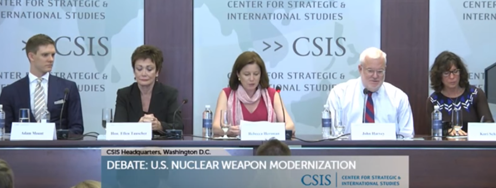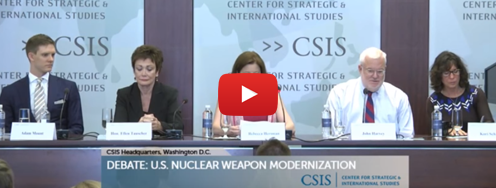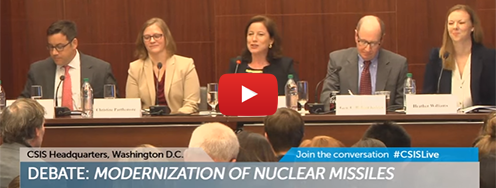Defense Experts Warn Nuclear Buildup is “Unsustainable and Must Be Rethought”
CBO finds U.S. nuclear arsenal costs skyrocketing. $1.7 trillion price tag threatens other military programs. Alternative force structures cheaper, safer.
Washington, DC -- Yesterday, the Congressional Budget Office, CBO, released a new report estimating that the Trump administration’s plans to maintain and replace the U.S. nuclear arsenal over 30 years would cost $1.2 trillion in constant dollars. With inflation, the total cost would be roughly $1.7 trillion. This is a massive increase over previous estimates and is leading defense experts to warn President Trump that the plans must be scaled back.
The new CBO report is the most comprehensive estimate to date of the total cost of rebuilding the U.S. nuclear arsenal, consisting of new, controversial Intercontinental Ballistic Missiles (ICBMs), air-launched cruise missiles, strategic submarines, long-range bombers, and the nuclear warheads they carry. Previous Pentagon cost estimates ranged from $350 billion to $1 trillion.
In response to the new report, William J. Perry, former Secretary of Defense, and General James E. Cartwright, former Vice Chairman, Joint Chiefs of Staff, and former Commander of U.S. Strategic Command sent a letter to President Trump warning that CBO’s new estimate “should be a wake up call that current plans to rebuild the nuclear arsenal are unsustainable and must be rethought. Now is the time to stop and ask ourselves: which weapons do we need to maintain deterrence in the future, and which can we do without?”
“The rising cost of rebuilding the nuclear arsenal is a warning that these plans are unaffordable,” they argue. “We should consider all aspects of our nuclear posture, and our conventional forces’ needs, before rushing headlong into these expensive and contentious development programs.”
In the letter, Perry and Cartwright express their support for new, nuclear-armed submarines and stealth bombers. But they question the need for a new generation of nuclear-armed cruise missiles and ICBMs, which together would cost roughly $150 billion.
They write, “our ICBMs are in danger of being launched in the case of another false alarm (we have experienced three to date), thereby starting a civilization-ending nuclear war by accident. This is not a theoretical problem; we had three false alarms during the Cold War, and on one of those, we narrowly averted a nuclear catastrophe.”
Perry and Cartwright state that taking a more prudent course in rebuilding the U.S. arsenal would not only save money and help avoid accidental nuclear war, but would also “help avoid a new arms race with Russia that neither side should want.” They point out that our current nuclear arsenal “was designed to fight an adversary that disappeared 25 years ago. Current Russian belligerence, although worrisome, does not constitute a renewed Cold War.”
“The current nuclear modernization budget is growing at an unsustainable rate,” agreed John Tierney, Executive Director of The Center for Arms Control and Non-Proliferation. “This unnecessary spending is drawing critical resources away from other pressing military priorities.” Jon Wolfsthal, non-resident fellow at the Belfer Center and the Carnegie Endowment for International Peace, points out that the report represents a 20% increase from an estimate by the Center for Nonproliferation Studies two years ago.
“The report blows apart the "do everything or do nothing" false choice repeatedly posited by Pentagon officials,” tweeted Kingston Reif of the Arms Control Association. The sheer size of the cost estimates in the report belie the all-or-nothing approach taken by hawks: “Military leaders, lawmakers, and defense contractors have been relentlessly pushing the excessive ‘all of the above’ modernization program under a false promise of a choice between modernizing or not having a nuclear deterrent or not,”says Hans Kristensen of the Federation of American Scientists. “If the White House, DOD, and Congress don’t make the right choices about priorities now at the outset of the modernization programs, future defense budgets will make the decisions for them.”
Tom Z. Collina, Policy Director at Ploughshares Fund, said that, “Many elements of Trump’s nuclear spending spree are excessive and dangerous, and we would be safer and richer without them.” He cautioned against giving President Trump new weapons that could be used first in a crisis, or would make nuclear war more likely. “Americans are not comfortable with Trump’s finger on the nuclear button,” Collina said. “Let’s not give Trump new nukes that he might actually use.”
More resources:
--“Trump Plans for Nuclear Arsenal Require $1.2 Trillion, Congressional Review States” by William Broad and David Sanger for The New York Times, October 31, 2017 here.
--“U.S. nuclear arsenal to cost $1.2 trillion over next 30 years: CBO” by Mike Stone and Idrees Ali for Reuters, October 31, 2017 here.
--“Trillion-dollar nuclear arms plan sets up budget brawl” by Gregory Hellman for POLITICO, October 31, 2017 here.



